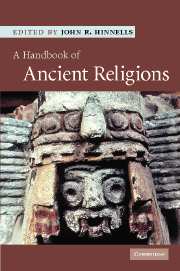Book contents
- Frontmatter
- Contents
- List of illustrations
- List of maps
- List of tables
- List of contributors
- Introduction
- 1 Palaeolithic art and religion
- 2 Ancient Egypt
- 3 Religion in ancient Ugarit
- 4 Mesopotamia
- 5 Ancient Israel to the fall of the Second Temple
- 6 Greek religion
- 7 Religions in the Roman Empire
- 8 Ancient Europe
- 9 The Indus Civilization
- 10 The religion of ancient China
- 11 Aztec and Inca civilizations
- Index
- References
10 - The religion of ancient China
- Frontmatter
- Contents
- List of illustrations
- List of maps
- List of tables
- List of contributors
- Introduction
- 1 Palaeolithic art and religion
- 2 Ancient Egypt
- 3 Religion in ancient Ugarit
- 4 Mesopotamia
- 5 Ancient Israel to the fall of the Second Temple
- 6 Greek religion
- 7 Religions in the Roman Empire
- 8 Ancient Europe
- 9 The Indus Civilization
- 10 The religion of ancient China
- 11 Aztec and Inca civilizations
- Index
- References
Summary
Presuppositions
Towards the end of the nineteenth century, when China was still ruled by the last of its dynastic houses, scholars intimately familiar with China's traditional culture would have been able to write the history of ancient Chinese religion perfectly and with great assurance. Now, at the start of a new millennium, the task is considerably more difficult, and one that a modern scholar – and especially a western scholar – approaches with much less confidence. This is not at all because we know less now about either ancient China or religion than did scholars a century ago. Indeed, with respect to ancient China (by which for the purposes of this chapter I will mean the roughly thousand years from the appearance of the first historical records about 1200 BCE until the establishment of a unified Chinese empire about 200 BCE), the last hundred years have been a time of unprecedented discovery of new sources. Some of these new sources give first-hand evidence of cultural practices that were still alive or at least well known to traditional scholars. Others, however, would have dumbfounded those scholars, as they do us today. They show us a culture more colourful, more discordant, more pungent than we could have ever imagined. To try not just to describe, but also to make some sort of coherent sense, of these new sights, sounds and smells would require, ideally, the curiosity of an archaeologist, the precision of an engineer and the inspiration of an artist.
- Type
- Chapter
- Information
- A Handbook of Ancient Religions , pp. 490 - 536Publisher: Cambridge University PressPrint publication year: 2007
References
- 2
- Cited by



